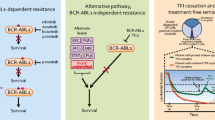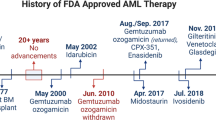Abstract
The myeloid malignancies include the myeloproliferative neoplasms (MPN) including chronic myeloid leukemia (CML), and acute myeloid leukemia (AML). A growing body of evidence documents that these diseases are caused by genetic mutations that constitutively activate tyrosine kinases. They include the BCR/ABL in CML, the V617F JAK2 in Philadelphia chromosome–negative MPN, and the Flt3 ITD and TKD mutations in AML. Trials of the ABL kinase inhibitor, imatinib, have revolutionized the treatment of CML, and there are ongoing studies with other kinase inhibitors in MPN and AML. Here we review results of recent studies with first-generation JAK2 inhibitors in the treatment of MPN and second-generation ABL and Flt3 inhibitors in CML and AML, respectively. It is becoming apparent that although these kinase mutations have similar effects in vitro, each of the diseases has unique features that alter the use of kinase inhibitors in the clinic.
Similar content being viewed by others
References
Papers of particular interest, published recently, have been highlighted as: • Of importance •• Of major importance
UNAIDS: WHO Classification of Tumors of the Haemopoietic and Lymphoid Tissues. Edited by Swerdlow CE, Harris SH. WHO; 2008.
Druker BJ, et al.: Five-year follow-up of patients receiving imatinib for chronic myeloid leukemia. N Engl J Med 2006, 355:2408–2417.
Hochhaus A, et al.: Dasatinib induces durable cytogenetic responses in patients with chronic myelogenous leukemia in chronic phase with resistance or intolerance to imatinib. Leukemia 2008, 22:1200–1206.
Kantarjian HM, et al.: Nilotinib (formerly AMN107), a highly selective BCR-ABL tyrosine kinase inhibitor, is effective in patients with Philadelphia chromosome-positive chronic myelogenous leukemia in chronic phase following imatinib resistance and intolerance. Blood 2007, 110:3540–3546.
Weisberg E, et al.: Characterization of AMN107, a selective inhibitor of native and mutant Bcr-Abl. Cancer Cell 2005, 7:129–141.
Shah NP, et al.: Overriding imatinib resistance with a novel ABL kinase inhibitor. Science 2004, 305:399–401.
Kantarjian HM, et al.: Optimizing therapy for patients with chronic myelogenous leukemia in chronic phase. Cancer 2010, 116:1419–1430.
•• Saglio G, et al.: Nilotinib versus imatinib for newly diagnosed chronic myeloid leukemia. N Engl J Med 2010, 362(24):2251–2259.
•• Kantarjian H, et al.: Dasatinib versus imatinib in newly diagnosed chronic-phase chronic myeloid leukemia. N Engl J Med 2010, 362(24):2260–2270.
Dameshek W: Some speculations on the myeloproliferative syndromes. Blood 1951, 6:372–375.
Baxter EJ, et al.: Acquired mutation of the tyrosine kinase JAK2 in human myeloproliferative disorders. Lancet 2005, 365:1054–1061.
Kralovics R, et al.: A gain-of-function mutation of JAK2 in myeloproliferative disorders. N Engl J Med 2005, 352:1779–1790.
Levine RL, et al.: Activating mutation in the tyrosine kinase JAK2 in polycythemia vera, essential thrombocythemia, and myeloid metaplasia with myelofibrosis. Cancer Cell 2005, 7:387–397.
James C, et al.: A unique clonal JAK2 mutation leading to constitutive signalling causes polycythaemia vera. Nature 2005, 434:1144–1148.
Hexner EO, et al.: Lestaurtinib (CEP701) is a JAK2 inhibitor that suppresses JAK2/STAT5 signaling and the proliferation of primary erythroid cells from patients with myeloproliferative disorders. Blood 2008, 111:5663–5671.
Pardanani A, et al.: TG101209, a small molecule JAK2-selective kinase inhibitor potently inhibits myeloproliferative disorder-associated JAK2V617F and MPLW515L/K mutations. Leukemia 2007, 21:1658–1668.
Quintas-Cardama A, et al.: Preclinical characterization of the selective JAK1/2 inhibitor INCB018424: therapeutic implications for the treatment of myeloproliferative neoplasms. Blood 2010, 115:3109–3117.
Verstovsek S, Kantarjian H, Mesa RA, et al.: Long-term follow up and optimized dosing regimen of INCB018424 in patients with myelofibrosis: durable clinical, functional and symptomatic responses with improved hematological safety. In 51st American Society of Hematology. New Orleans: 2009.
Pardanani A, Gotlib JR, Jamieson C, et al.: A phase I evaluation of TG101348, a selective JAK2 inhibitor, in myelofibrosis: clinical response is accompanied by significant reduction in JAK2V617F allele burden. In 51st American Society of Hematology. New Orleans: 2009.
Santos FP, et al.: Phase 2 study of CEP-701, an orally available JAK2 inhibitor, in patients with primary or post-polycythemia vera/essential thrombocythemia myelofibrosis. Blood 2010, 115:1131–1136.
Hexner E, Goldberg JD, Prchal JT, et al.: A multicenter, open label phase I/II study of CEP701 (lestaurtinib) in adults with myelofibrosis; a report on phase I: A Study of the Myeloproliferative Disorders Research Consortium (MPD-RC). In 51st American Society of Hematology. New Orleans: 2009.
Mesa RA, et al.: The Myelofibrosis Symptom Assessment Form (MFSAF): an evidence-based brief inventory to measure quality of life and symptomatic response to treatment in myelofibrosis. Leuk Res 2009, 33:1199–1203.
Moliterno A, Hexner E, Roboz GJ, et al.: An open-label study of CEP-701 in patients with JAK2 V617F-positive PV and ET: update of 39 enrolled patients. In 51st American Society of Hematology. New Orleans: 2009.
Verstovsek S, Passamonti F, Rambaldi A, et al.: A Phase 2 study of INCB018424, an oral, selective JAK1/JAK2 inhibitor, in patients with advanced polycythemia vera (PV) and essential thrombocythemia (ET) refractory to hydroxyurea. In 51st American Society of Hematology. New Orleans: 2009.
Swerdlow SH, Harris CN: WHO Classification of Tumors of Haematopoietic and Lymphoid Tissues. Lyon: IARC; 2008.
Goldstone AH, et al.: Attempts to improve treatment outcomes in acute myeloid leukemia (AML) in older patients: the results of the United Kingdom Medical Research Council AML11 trial. Blood 2001, 98:1302–1311.
Rowe JM, et al.: A phase 3 study of three induction regimens and of priming with GM-CSF in older adults with acute myeloid leukemia: a trial by the Eastern Cooperative Oncology Group. Blood 2004, 103:479–485.
Mardis ER, et al.: Recurring mutations found by sequencing an acute myeloid leukemia genome. N Engl J Med 2009, 361:1058–1066.
Rucker FG, et al.: Disclosure of candidate genes in acute myeloid leukemia with complex karyotypes using microarray-based molecular characterization. J Clin Oncol 2006, 24:3887–3894.
Schlenk RF, et al.: Mutations and treatment outcome in cytogenetically normal acute myeloid leukemia. N Engl J Med 2008, 358:1909–1918.
Suela J, et al.: DNA profiling analysis of 100 consecutive de novo acute myeloid leukemia cases reveals patterns of genomic instability that affect all cytogenetic risk groups. Leukemia 2007, 21:1224–1231.
Small D, et al.: STK-1, the human homolog of Flk-2/Flt-3, is selectively expressed in CD34+ human bone marrow cells and is involved in the proliferation of early progenitor/stem cells. Proc Natl Acad Sci U S A 1994, 91:459–463.
Small D: FLT3 mutations: biology and treatment. Hematol Am Soc Hematol Educ Program 2006, 178–184.
Yamamoto Y, et al.: Activating mutation of D835 within the activation loop of FLT3 in human hematologic malignancies. Blood 2001, 97:2434–2439.
Griffith J, et al.: The structural basis for autoinhibition of FLT3 by the juxtamembrane domain. Mol Cell 2004, 13:169–178.
Levis M, Small D: FLT3: It does matter in leukemia. Leukemia 2003, 17:1738–1752.
Kiyoi H, et al.: Mechanism of constitutive activation of FLT3 with internal tandem duplication in the juxtamembrane domain. Oncogene 2002, 21:2555–2563.
Abu-Duhier FM, et al.: Identification of novel FLT-3 Asp835 mutations in adult acute myeloid leukaemia. Br J Haematol 2001, 113:983–988.
Kottaridis PD, et al.: The presence of a FLT3 internal tandem duplication in patients with acute myeloid leukemia (AML) adds important prognostic information to cytogenetic risk group and response to the first cycle of chemotherapy: analysis of 854 patients from the United Kingdom Medical Research Council AML 10 and 12 trials. Blood 2001, 98:1752–1759.
Pratz K, Levis M: Incorporating FLT3 inhibitors into acute myeloid leukemia treatment regimens. Leuk Lymphoma 2008, 49:852–863.
Stone RM, et al.: Patients with acute myeloid leukemia and an activating mutation in FLT3 respond to a small-molecule FLT3 tyrosine kinase inhibitor, PKC412. Blood 2005, 105:54–60.
Smith BD, et al.: Single-agent CEP-701, a novel FLT3 inhibitor, shows biologic and clinical activity in patients with relapsed or refractory acute myeloid leukemia. Blood 2004, 103:3669–3676.
Giles FJ, et al.: SU5416, a small molecule tyrosine kinase receptor inhibitor, has biologic activity in patients with refractory acute myeloid leukemia or myelodysplastic syndromes. Blood 2003, 102:795–801.
O’Farrell AM, et al.: An innovative phase I clinical study demonstrates inhibition of FLT3 phosphorylation by SU11248 in acute myeloid leukemia patients. Clin Cancer Res 2003, 9:5465–5476.
• Ravandi F, et al.: Phase I/II study of combination therapy with sorafenib, idarubicin, and cytarabine in younger patients with acute myeloid leukemia. J Clin Oncol 2010, 28(11):1856–1862.
Pratz KW, et al.: A pharmacodynamic study of the FLT3 inhibitor KW-2449 yields insight into the basis for clinical response. Blood 2009, 113:3938–3946.
Cortes JFJ, Ghirdaladze D, et al.: AC220, a potent, selective, second generation FLT3 receptor tyrosine kinase (RTK) inhibitor, in a first-in-human (FIH) phase 1 AML study. In 51st Meeting of the American Society of Hematology. New Orleans: 2009.
Levis M, Wang RF, et al.: Results from a randomized trial of salvage chemotherapy followed by lestaurtinib for FLT3 mutant AML patients in first relapse. In 51st Meeting of the American Society of Hematology. New Orleans: 2009.
Zarrinkar PP, et al.: AC220 is a uniquely potent and selective inhibitor of FLT3 for the treatment of acute myeloid leukemia (AML). Blood 2009, 114:2984–2992.
Stone RM, et al.: A phase 1b study of midostaurin (PKC412) in combination with daunorubicin and cytarabine induction and high-dose cytarabine consolidation in patients under age 61 with newly diagnosed de novo acute myeloid leukemia: Overall survival of patients whose blasts have FLT3 mutations is similar to those with wild-type FLT3. In 51st Meeting of the American Society of Hematology. New Orleans: 2009.
Disclosure
Dr. Hexner has served as an advisor to Cephalon Oncology. Dr. Carroll receives partial salary support from the United States Veterans Administration. Dr. Carroll receives grant support for research from Sanofi-Aventis, Agios Pharmaceuticals, and TetraLogic Pharmaceuticals. Dr. Carroll has acted as a consultant to Cephalon Oncology. Dr. Perl has no disclosures. Dr. Scott receives partial salary support through the Pfizer Oncology Clinical Fellowship.
Author information
Authors and Affiliations
Corresponding author
Rights and permissions
About this article
Cite this article
Scott, E., Hexner, E., Perl, A. et al. Targeted Signal Transduction Therapies in Myeloid Malignancies. Curr Oncol Rep 12, 358–365 (2010). https://doi.org/10.1007/s11912-010-0126-z
Published:
Issue Date:
DOI: https://doi.org/10.1007/s11912-010-0126-z




